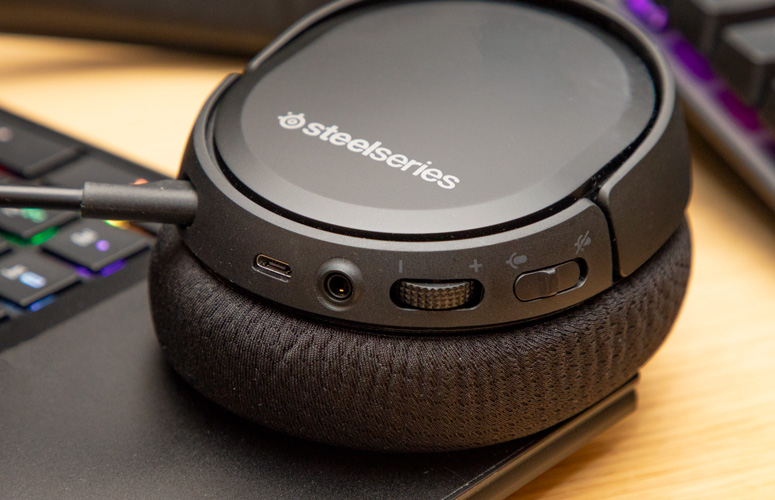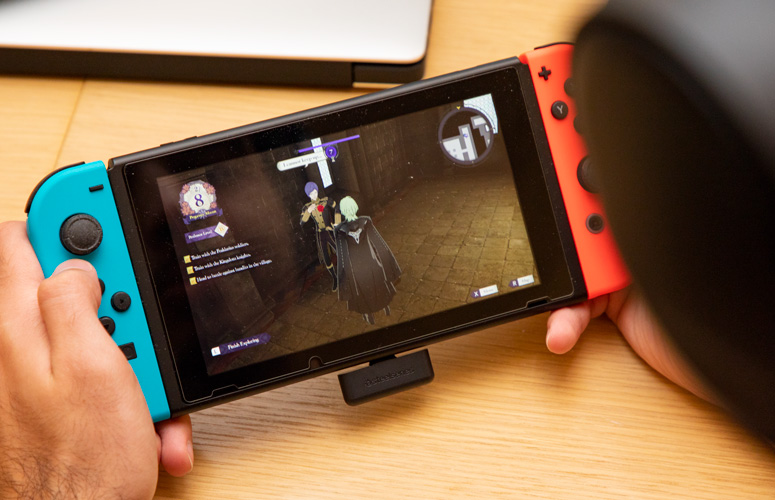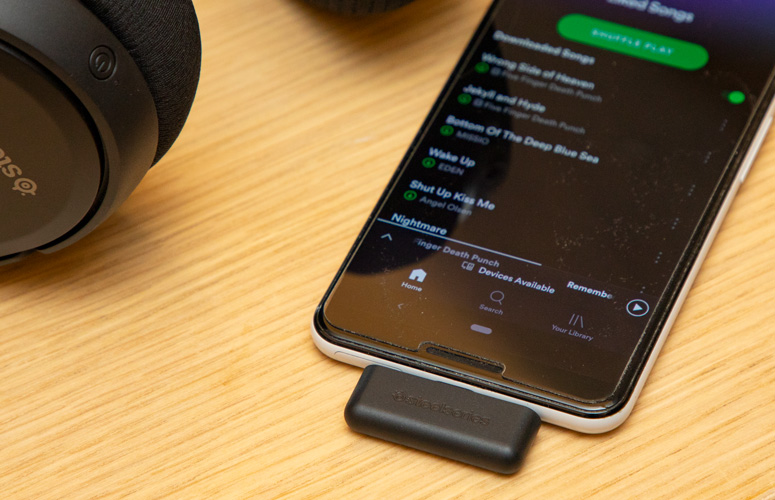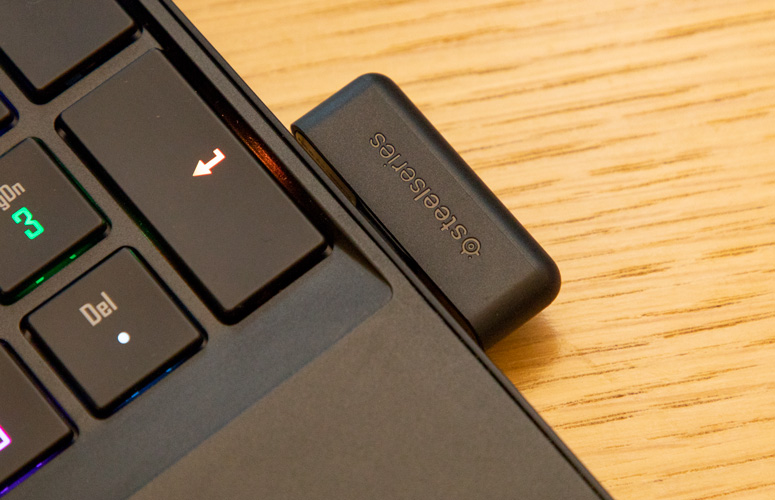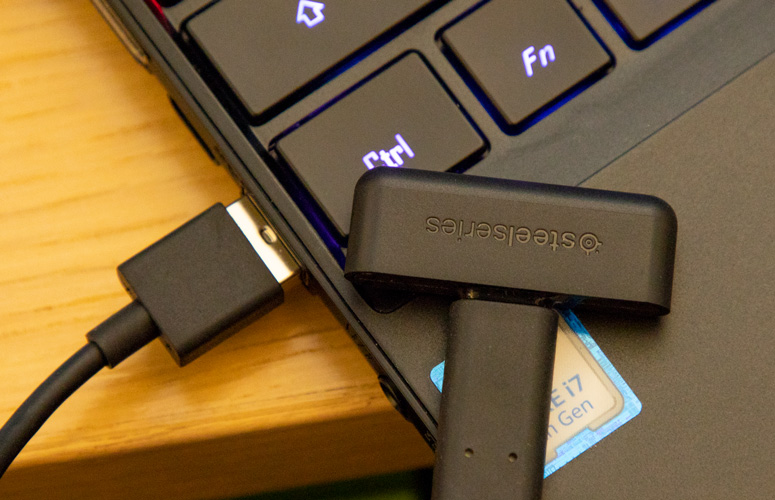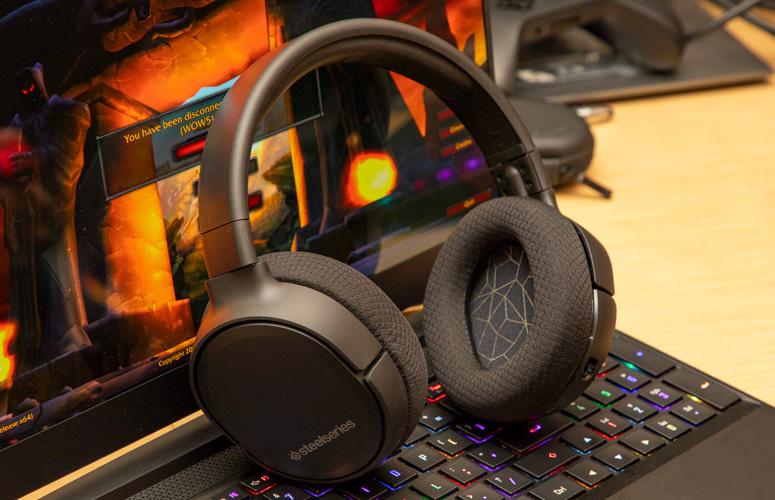Laptop Mag Verdict
The SteelSeries Arctis 1 Wireless is the first gaming headset to use a USB Type-C dongle. Oh, and it sounds great and feels good, too.
Pros
- +
Excellent wireless
- +
Several included adapters
- +
Comfortable ear cups
- +
Software with EQ settings
- +
Solid overall gaming sound
Cons
- -
Dongle is wide for most laptops
- -
A little big
- -
Muddy bass
Why you can trust Laptop Mag
The SteelSeries Arctis 1, one of the best budget gaming headsets around, has gone full wireless, and is the first headset to use a USB Type-C dongle. For $99, the SteelSeries Arctis 1 Wireless not only loses the constraints of a cable, but it's also compatible with the SteelSeries Engine 3 software to deliver a customizable EQ. Of course, the Arctis 1 still has the same comfortable ear cups and solid overall gaming sound.
Despite that, the 2.4GHz dongle is a little wide for most gaming laptops, and, surprisingly, the fit is slightly bigger than that of the previous model. And even with customizable EQ settings, there's still some muddy bass.
Still, the SteelSeries Arctis 1 Wireless is a great implementation of wireless connectivity in the Arctis 1 gaming headset, and it's especially innovative as it's the first headset to use a USB Type-C dongle.
Design
Not a lot has changed in the Arctis 1's design, apart from it going wireless. The headset features the same discreet, yet luxurious design. It's not cheap, nor does it look needlessly gaudy. You won't feel self-conscious wearing this bad boy out in public. However, it would have been nice to see some changes, considering that it's double the price of the wired model.
The ear cups sport a matte black finish, and toward the bottom of each cup is a SteelSeries logo. Painted within the ear cups is SteelSeries' signature polygon design. Like the wired iteration, the Arctis 1 Wireless features an adjustable, steel-reinforced band. The steel band is wrapped around a black plastic headband, and on the underside there's a sleek, pleather cushion just for your head.
You won't feel self-conscious wearing this bad boy out in public.
There is only one additional control on the Arctis 1 compared with the original and that's the power button, which is located on the right ear cup. I don't like that the button sinks into the chassis and that it's located at the bottom of the cup. It makes it somewhat annoying to get to and turn on.
Sign up to receive The Snapshot, a free special dispatch from Laptop Mag, in your inbox.
The other controls include the mute switch and the volume dial, which are on the left cup. Here, you can also find the 3.5-mm audio jack, a micro USB input for charging and the input for the detachable microphone. The microphone hasn't changed, either, as it's still short and flexible.
In the box, you'll find the USB Type-C 2.4 GHz wireless dongle, a USB Type-C-to-USB Type-A adapter, a 3.5mm aux cord, and a micro USB charging cable. While you won't find a split cable for the headphone and microphone, like the original Arctis 1, the included adapter for USB Type-A ports is pretty neat, making it accessible for all gaming laptops.
Comfort
Surprisingly, the Arctis 1's Airweave fabric ear cushions felt a little stiffer than those of the original Arctis 1, as I compared them side by side. The fit was a little off as well. The wired one fit perfectly over my ears, but the wireless version sits a little farther down on my head, despite being in the tightest position.
Surprisingly, even the pleather cushion under the band is slightly stiffer. Of course, it's tough to notice this difference if you aren't comparing the two side by side. Despite not being as soft, the headset's cups are still comfortable. I just wish the band was a little smaller. And as I mentioned in the previous Arctis 1 review, it would be nice if there were notches on the steel band that indicated its position.
Regardless, at 9.6 ounces, the Arctis 1 Wireless was still incredibly light on my head and it didn't shift around when I moved.
Gaming performance
I had a blast while gaming with the Arctis 1 Wireless. It definitely needs to ramp up the bass, but overall, it sounded good.
In Remnant: Rise from the Ashes on the PC, I fired a crossbow bolt into a group of enemies, and the sharp snap of the release followed by piecing of the skin sounded incredibly satisfying. Rolling around on metal plating had a decent enough echo to sound immersive, although it could've used a little more bass. When I talked to the merchants, their voices were clear, but not as crisp.
In Remnant: Rise from the Ashes, I fired a crossbow bolt into a group of enemies, and the sharp snap of the release followed by piecing of the skin sounded incredibly satisfying.
I played Fire Emblem: Three Houses on the Nintendo Switch, and when I was building support between Edelgard and Ferdinand (Black Eagles for life!), their voices could have sounded a little brighter. When I was in combat, the blasts from my Levin Sword sounded electrifying (literally), and Edelgard's Fire spell emitted a solid thud upon hitting an enemy, followed by a nice sizzle.
In the best kart racer in the world, Crash Team Racing Nitro-Fueled, the sound of burning rubber and my triple boost igniting sounded smooth. When I fired a rocket at the obviously cheating polar bear named Polar, the missile pierced through the air until it hit its target, but the following explosion didn't sound as full as it could have been. And when that sneaky little bear overtook me by an annoyingly improbable 3 milliseconds, Crash's angry reaction sounded thick, and as bitter as I felt.
Music performance
The Arctis 1 is loud, and while it doesn't provide enough bass for music, the sound is decent overall.
I listened to Five Finger Death Punch's "Jekyll and Hyde," and the opening vocals of the song weren't provided enough bass to bring it above the guitar in the background. When the chorus dropped, the vocals and the guitar blended well together. But I could barely make out the percussion in the background.
I had a similar issue while listening to Arctic Monkeys' "R U Mine?" The bass guitar was muddy, and while the percussion sounded decent, it should've been stronger, especially the bass drum. Despite that, the vocals were bright, and the riffs on the electric guitar shined.
In Missio's "I see you," the percussion was surprisingly loud, but still a little thin. The backup vocals and lead vocals were crisp during the chorus. It did get a little sharp when the tambourine came in. However, the piano sounded smooth.
Microphone
The Arctis 1's detachable microphone was solid when I tested it.
I hopped into a discord call with my colleague and best friend in the whole world Michael Andronico, who also used the same headset, and his voice was clear and crisp. And even though he was conversing with me in the middle of a packed office, I could barely hear any background noise. However, there were moments were the microphone sounded like it was clipping at higher pitched sounds. I noticed this while I was talking and could hear it via the sidetone. For context, the microphone on the wired Arctis 1 also peaked as well.
Features
You can connect the Arctis 1 Wireless to not only your laptop, but to every major console you own (and to most USB-C smartphones).
It can connect to the Nintendo Switch via USB Type-C, the PS4 (and a docked Switch) via the USB Type-A-to-Type-C adapter and the Xbox One via the 3.5mm audio jack. It can also connect to android phones via USB Type-C (iPhones don't play well even with a Type-C-to-Lightning adapter). My headset stayed connected to my computer even when I was 20 or so feet away in my kitchen.
The USB Type-C dongle will work with some phone cases, but the case on my Pixel 3 was just slightly too thick for it. So the dongle probably won't fit on an Otterbox. And one of the issues with using a USB Type-C dongle is that it may cover ports on your gaming laptop, so you probably should resort to using the USB Type-A adapter.
While there are no on-board EQ settings, the SteelSeries Engine 3 app on your computer allows you to customize everything you could possibly need. Most important, there's the customizable equalizer as well as several included presets. I found that Music worked best for, well, music. And that Immersion worked best for gaming. You can also adjust the power options, the level of the microphone sidetone, microphone volume and dynamic range compression. All your custom settings will be saved on the headset even when you're not on your computer.
SteelSeries rates the battery life on the Arctis 1 Wireless for 20-plus hours, which lines up with my testing. I used it for 2 hours commuting Monday through Friday and also spent several 5hour-long play sessions with it on afterward without charging it.
Bottom line
The SteelSeries Arctis 1 Wireless boasts excellent wireless connectivity with adapters for just about any device you'd want to use it on. It has comfortable ear cups to bless you with that sweet gaming sound, and its software makes that same audio customizable. However, the bass is still muddy, the fit might be a little big and you may find the dongle bothersome if your laptop is exclusively USB Type-C.
If you're looking for a cheaper wireless alternative, go with the $80 PDP LVL 50 Wireless Headset, but know that you're going to hear a lesser quality sound and build. If you're willing to spend more, go with the $120 Turtle Beach Stealth 700, which features impressive sound quality and, for better or worse, uses Bluetooth.
But overall, the SteelSeries Arctis 1 Wireless is the best wireless gaming headset you can get for $99.
Credit: Laptop Mag
- 11 Cheap VR Headsets (Under $45) Ranked from Best to Worst ...
- Microsoft Mixed Reality Headsets: What You Need to Know
- 7 Cheap PC Headsets (Under $35) Ranked Best to Worst
SteelSeries Arctis 1 Wireless Specs

Rami Tabari is the Reviews Editor for Laptop Mag. He reviews every shape and form of a laptop as well as all sorts of cool tech. You can find him sitting at his desk surrounded by a hoarder's dream of laptops, and when he navigates his way out to civilization, you can catch him watching really bad anime or playing some kind of painfully difficult game. He’s the best at every game and he just doesn’t lose. That’s why you’ll occasionally catch his byline attached to the latest Souls-like challenge.

